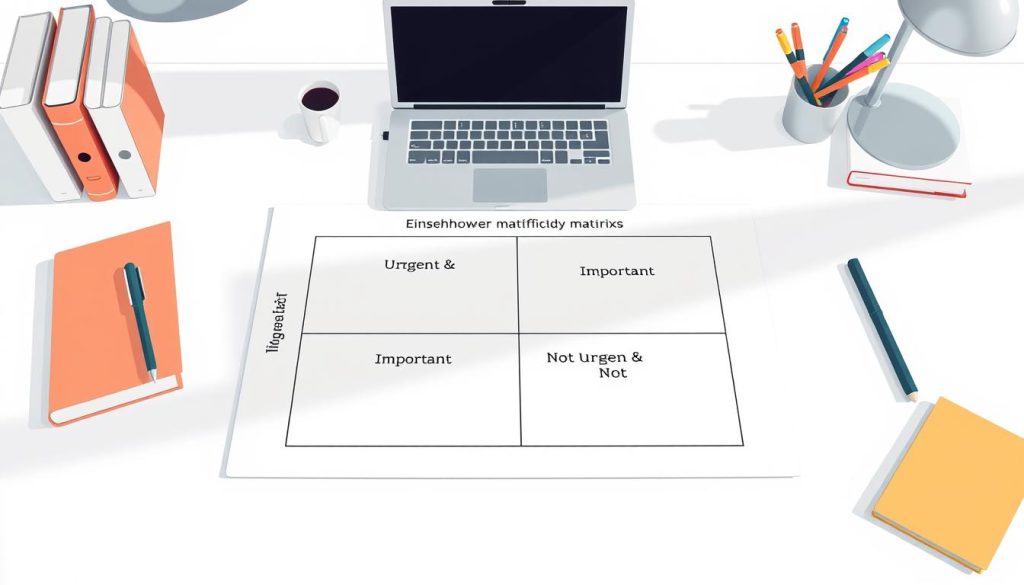We’ve all been there – juggling classes, assignments, and maybe even a part-time job. It’s easy to feel like there just aren’t enough hours in the day. Efficient study habits are key for success, even when time is scarce.
Research shows good study habits lead to better grades. By focusing on your studying and managing your time effectively, you can learn more. This makes the most of your time.
Key Takeaways
- Prioritize your studying to make the most of your limited time.
- Develop efficient study habits to boost your productivity.
- Learn to manage your time effectively to achieve academic success.
- Discover practical tips to retain information better.
- Improve your overall study experience with our expert advice.
Understanding the Challenges of Studying When You’re Short of Time
Studying when time is tight is tough. It’s key to know the challenges to find good ways to study. Students often have a lot to do, like classes, homework, jobs, and clubs. It’s hard to find time to study.
Common Time Constraints for Students
Students face many time limits that make studying hard. These include:
- Heavy course loads with many assignments and exams
- Part-time jobs or internships that take up a lot of time
- Clubs and sports that take up time
- Family or personal duties
Knowing these common problems helps us find ways to beat them. A study by the American Psychological Association showed that good time management lowers stress and boosts grades.
“Time is a great teacher, but unfortunately it kills all its pupils.” – Louis Hector Berlioz
This quote shows how vital it is to use our time well. By focusing on what’s important and managing our time, we can reach our goals despite the hurdles.
The Impact of Time Pressure on Learning Efficiency
Time pressure can really hurt how well we learn. When we’re in a hurry, we often:
| Effect of Time Pressure | Impact on Learning |
|---|---|
| Rushed Study Sessions | Less retention and understanding of material |
| Increased Stress Levels | Worse thinking and memory |
| Lack of Practice and Review | Not ready for exams and assignments |
Knowing these effects helps us find ways to lessen them. For example, good time management can reduce stress and make learning better.
Effective time management is crucial for studying when you’re short on time. By knowing common time limits and the effects of pressure, we can find ways to succeed academically.
Assessing Your Available Study Time
Let’s explore how to find extra time for learning. To get better at studying, you need to see how you use your time now.
Start by doing a personal time audit. For a week, track your time from waking up to bedtime. Note down study sessions, classes, work, meals, commute, and fun activities. This will show you where you can adjust your schedule to study more.
Conducting a Personal Time Audit
To do a good time audit, be honest about your time use. Use a planner, spreadsheet, or app to log your activities. You might find out you spend a lot of time on things that aren’t essential. This can help you make room for more study time.
Identifying Hidden Pockets of Time in Your Schedule
After seeing how you spend your time, find hidden pockets of time for studying. Use your commute, breaks between classes, or waiting in line for study sessions. These moments can help you make good progress without feeling stressed.
By checking your study time and finding ways to improve, you can create study hacks for limited time that fit you. This smart way of managing time will help you keep up with school and reach your goals.
Setting Realistic Study Goals for Limited Timeframes
When time is short, setting doable study goals is key to success. Studying fast can feel overwhelming. But, with the right plan, you can use your time wisely.
First, know that setting realistic goals means being honest about what you can do in the time you have. It’s about being smart with your study goals and focusing on what’s most important.
Creating SMART Study Objectives
Creating SMART study goals is a smart way to set goals. SMART means Specific, Measurable, Achievable, Relevant, and Time-bound. This helps you make a clear study plan.
- Specific: Clearly define what you want to achieve.
- Measurable: Quantify your goals so you can track progress.
- Achievable: Ensure your goals are realistic based on your available time and resources.
- Relevant: Align your study goals with your overall academic objectives.
- Time-bound: Set deadlines for achieving your study goals.
For example, instead of saying “I want to study more,” a SMART goal is “I will study for 30 minutes each day for the next week to review my notes on topic X.” This keeps you focused and motivated.
Breaking Down Large Topics into Manageable Chunks
Another key strategy is breaking down big topics into smaller parts. This makes studying less scary and lets you focus on one part at a time. It’s a great way to use your study time well.
Begin by finding the main parts of a big topic you need to cover. Then, split these parts into smaller sections. Make a study plan for each section. This helps you prioritize studying and remember things better.
By using these strategies, you can make the most of your study time and reach your academic goals, even when time is tight.
Prioritization Techniques for Efficient Studying
To make the most of your study time, it’s key to prioritize well. Focusing on the most important material helps you use your time wisely. This ensures you cover the critical topics.
The Eisenhower Matrix for Study Materials
The Eisenhower Matrix is a great tool for sorting your study materials. It categorizes tasks by urgency and importance. This helps you quickly see which topics to tackle first.
- Urgent and Important: Topics that are critical and have a deadline, such as upcoming exams or assignments.
- Important but Not Urgent: Topics that are crucial for your understanding but don’t have a deadline, such as reviewing notes or reading ahead.
- Urgent but Not Important: Tasks that can be handled quickly or by others, such as responding to non-essential messages.
- Not Urgent or Important: Activities that are not essential, such as excessive social media browsing.

Focusing on High-Yield Topics First
Starting with high-yield topics can boost your study efficiency. High-yield topics are key for exams and understanding other concepts. By focusing on these, you can make the most of your study time.
To find high-yield topics, check your course syllabus, past exams, and assignment guidelines. Look for areas your instructor often tests or emphasizes.
Identifying and Addressing Critical Knowledge Gaps
It’s crucial to identify and fill knowledge gaps for effective studying. Knowledge gaps are areas where you need more practice or understanding. By focusing on these, you ensure you’re ready for exams and assignments.
- Review your notes and past exams to identify areas where you struggled.
- Seek feedback from instructors or peers on your understanding of key concepts.
- Use practice quizzes or tests to pinpoint areas where you need more work.
By using these techniques to prioritize your study materials, you can maximize your study time. This helps you reach your academic goals.
Effective Strategies for Studying When You’re Short of Time
When time is tight, finding good study strategies is key. We’ve all faced huge study piles with little time. But, there are study hacks for limited time to keep you on track and make your study time count.
The Pomodoro Technique for Focused Study Sessions
The Pomodoro Technique is a great time management for studying method. It involves working in 25-minute focused sessions, then taking a five-minute break. This helps you stay focused and avoid burnout. After four cycles, take a 15-30 minute break to rest and recharge.
- Choose a task you want to work on.
- Set a timer for 25 minutes.
- Work on the task without any interruptions until the timer goes off.
- Take a five-minute break.
- Repeat the cycle.
Time Blocking for Consistent Study Habits
Time blocking means scheduling study sessions in your calendar like appointments. It helps you develop consistent study habits and use your time well. By sticking to your study schedule, you’ll make progress on your goals.
To start time blocking, figure out when you can study. Then, schedule it in your calendar. Be honest about how much you can do in each session.
Using Deadlines as Motivational Tools
Deadlines can be powerful accelerated learning techniques if used right. Setting realistic deadlines for your study goals adds urgency and motivation. Break big tasks into smaller ones and set deadlines for each.
For example, if you’re studying for an exam, set deadlines for each topic or chapter. This keeps you focused and ensures you’re making progress.
In short, when time is short, using effective study strategies is crucial. Techniques like the Pomodoro Technique, time blocking, and deadlines can help you make the most of your study time and reach your goals.
Accelerated Learning Techniques for Quick Knowledge Absorption
When time is tight, accelerated learning techniques can be a big help. They help you learn fast and remember what you learn. We’ll look at some top techniques to make your study time count.
Active Recall and Spaced Repetition Systems
Active recall means you actively try to remember information instead of just reading it. This makes it easier to remember and recall later. Spaced repetition helps by reviewing material at longer intervals to lock it in your memory.
Using both active recall and spaced repetition together boosts your learning. Here’s how to do it:
Implementing Flashcards Effectively
Flashcards are great for active recall. To use them well:
- Make digital or physical flashcards with questions on one side and answers on the other.
- Test yourself regularly by reviewing the flashcards.
- Use apps like Anki to add spaced repetition to your flashcards.
Creating Retrieval Practice Schedules
Retrieval practice means actively trying to remember information. To set up a good schedule:
- Choose the material you want to review.
- Set aside time each day to practice recalling it.
- Slowly increase the time between review sessions to use spaced repetition.
Mind Mapping for Rapid Information Organization
Mind mapping is a visual way to organize information. It creates a diagram that links related ideas, showing how they fit together. This helps you see the big picture and understand connections.
To make a mind map:
- Start with a central idea or concept.
- Add branches for related ideas and subtopics.
- Use colors, symbols, and images to make it engaging and memorable.

By using these techniques, you can learn faster and remember more. The key is to stay consistent and adjust these methods to fit how you learn best.
Optimizing Your Study Environment When Time is Limited
When time is tight, a good study space is key. It helps you focus and remember what you learn. A tidy, quiet spot can make a big difference.
Creating a Distraction-Free Zone
To study well, you must avoid distractions. Look for things that take your mind off your work, like social media or family talk. Create a distraction-free zone with website blockers or headphones. This keeps you on track.
Make a special study area at home. It doesn’t need to be fancy. Just a quiet spot works. Tell your family you’re studying to keep the peace. This way, you can focus without interruptions.
Preparing All Materials in Advance
Don’t waste time looking for what you need to study. Prepare all your study materials in advance to save time and stress. Get all your books, notes, and pens ready before you start.
Use a study planner or checklist to stay organized. Plan your study sessions ahead of time. This way, you cover everything without cramming. It saves time and helps you remember better.
By following these tips, you can make the most of your study time, even when it’s short. It’s not just about how much time you have. It’s about using it wisely.
Digital Tools and Apps for Time-Constrained Studying
In today’s fast-paced world, digital tools can change the game for students with tight schedules. There are many apps and tools out there. They help students study more efficiently and productively.
Digital tools cover many study areas, like note-taking and staying focused. Let’s look at some top digital tools and apps for students with limited time.
Note-Taking Apps for Quick Information Capture
Note-taking apps are key for quick and efficient info capture. Some top picks include:
- Evernote: Known for its organizational features and syncing across devices.
- OneNote: Offers flexible, free-form note-taking and integrates well with Microsoft Office.
- Simplenote: A simple app for plain text notes, great for those who like simplicity.
These apps let students capture info on the go, organize their notes, and access them anywhere.
Flashcard Applications for Efficient Review
Flashcard apps are perfect for efficient review. They use spaced repetition to reinforce learning.
- Anki: A powerful app for digital flashcards, using spaced repetition.
- Quizlet: Has a huge library of flashcard decks on various subjects, with games and tests.
These apps make reviewing more fun and effective. They help students memorize key concepts.
Focus and Productivity Apps
Staying focused is hard when studying under pressure. Focus and productivity apps help students stay on track and avoid distractions.
| App | Description | Platform |
|---|---|---|
| Forest | Grows a virtual forest as you stay focused, making productivity a game. | iOS, Android |
| Freedom | Blocks distracting websites and apps on all devices. | iOS, Android, Mac, Windows |
| Focus@Will | Offers music designed to help you concentrate. | iOS, Android, Web |
By using these digital tools and apps, students can boost their study efficiency. They can stay organized and focused, even with tight schedules.
Maximizing Retention When Study Time is Limited
When time is short, it’s key to learn fast. You must quickly absorb and remember information to use your study time well.
Memory Techniques for Quick Information Absorption
There are many memory techniques to learn quickly. These methods help you remember information when you need it.
The Memory Palace Technique
The Memory Palace technique, also known as the method of loci, uses a familiar place. You link the info you want to remember to spots in that place. It’s great for remembering lists or sequences.
Chunking and Association Methods
Chunking breaks down big info into smaller bits. Linking new info to something you know or find interesting helps remember it. You can make acronyms or rhymes to remember key terms or ideas.
Strategic Review Schedules
Having a review plan is key to keeping info in your memory. Spacing out your review helps solidify info in your long-term memory. This is based on the spaced repetition principle, which works well for keeping info long-term.
To make a review plan, first pick the main topics you need to cover. Then, schedule your review sessions, spreading them out over time. For example, review a topic one day, then again a week later, and once more after a month. This keeps the info fresh and stops it from fading away.
Balancing Self-Care and Studying Under Time Constraints
When you’re racing against the clock to study, it’s easy to forget that taking care of yourself is just as important as hitting the books. Neglecting your well-being can have serious consequences on your learning efficiency and overall academic performance.
Sleep: The Foundation of Efficient Learning
Getting enough sleep is crucial for memory consolidation and learning retention. During sleep, your brain processes and strengthens the connections between neurons, transferring information from short-term to long-term storage. Aim for 7-9 hours of sleep each night to ensure you’re well-rested and ready to tackle your study sessions.
To improve your sleep quality, establish a consistent sleep schedule, avoid caffeine and electronics before bedtime, and create a relaxing bedtime routine. By prioritizing sleep, you’ll be more focused and productive during your study sessions, making the most of your limited time.
Nourishing Your Brain: Nutrition and Exercise
A well-balanced diet and regular exercise are essential for maintaining optimal brain function. Focus on consuming nutrient-rich foods like fruits, vegetables, whole grains, lean proteins, and healthy fats. These foods provide the energy and nutrients your brain needs to function at its best.
Exercise is equally important, as it improves blood flow to the brain, boosting cognitive function and memory. Aim for at least 30 minutes of moderate-intensity exercise per day, such as brisk walking, cycling, or swimming. This can help reduce stress, improve mood, and enhance your overall learning experience.
| Nutrient | Food Sources | Benefits for Learning |
|---|---|---|
| Omega-3 Fatty Acids | Salmon, walnuts, chia seeds | Supports brain health and cognitive function |
| Antioxidants | Berries, leafy greens, dark chocolate | Protects against oxidative stress and inflammation |
| Complex Carbohydrates | Whole grains, fruits, vegetables | Provides sustained energy for studying |
Managing Stress When Studying Under Pressure
Studying under time pressure can be incredibly stressful, but there are effective strategies to manage this stress. Practice relaxation techniques like deep breathing, progressive muscle relaxation, or meditation to calm your mind and reduce anxiety.
It’s also essential to take regular breaks during study sessions. Use the Pomodoro Technique: study for 25 minutes, then take a 5-minute break. This can help you stay focused, avoid burnout, and maintain a sustainable study pace.
By balancing self-care with studying, you’ll not only improve your academic performance but also maintain your overall well-being. Remember, taking care of yourself is not a luxury, it’s a necessity for achieving success under tight deadlines.
Conclusion
We’ve looked at ways to study when time is tight. This includes figuring out how much time you have and making your study space better. These steps help you use your study time wisely and reach your goals.
Managing your study time well is key when you’re busy. Focus on what’s most important, use the Pomodoro Technique, and digital tools. This keeps you on track and helps you remember things better.
Getting good at studying takes time and effort. But with the right strategies, you can beat the pressure of tight schedules. Now, you have the tools to make a study plan that fits you, helping you stay focused and achieve your goals.
Remember, studying is more than just getting good grades. It’s about developing a love for learning that lasts a lifetime. By adopting these study habits, you’ll be ready for anything academic life throws your way.

